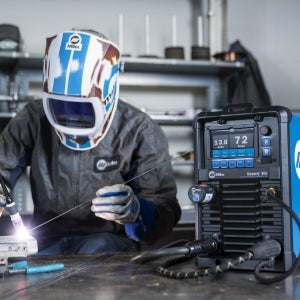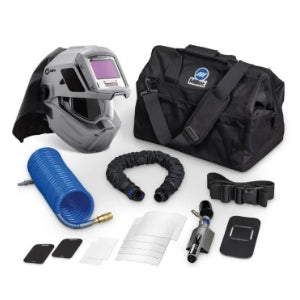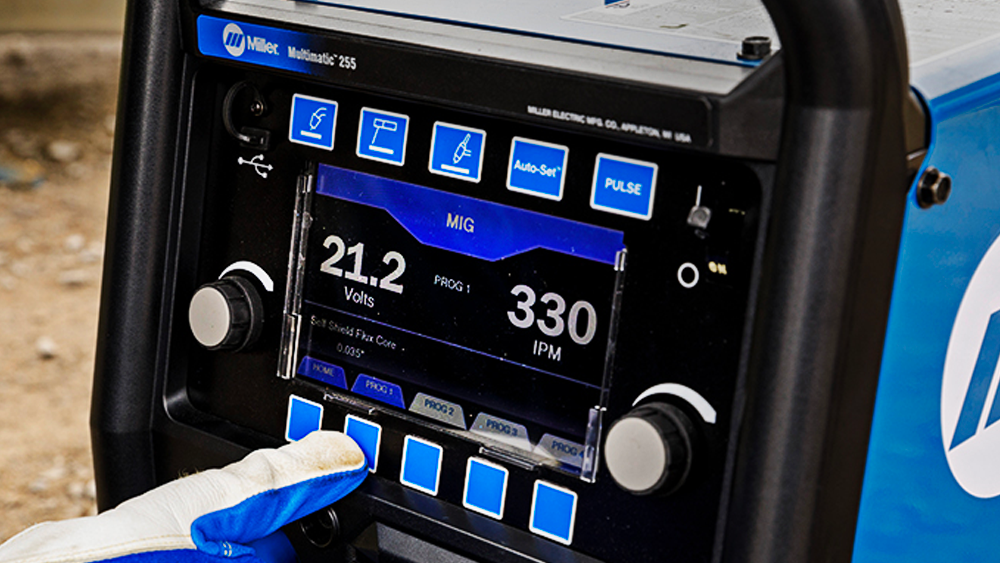Close your eyes. Imagine a grizzled man wearing a thick apron. In his hand, he holds a thick tree branch, which he jabs at a piece of metal, trying to produce an arc. For your average person, that’s often what comes to mind when someone says “stick welding.” While it’s amusing, the primitiveness of that mental image isn’t so far from the truth.
At the most basic level, bad stick welding can be done with just a car battery and a couple of jumper cables—in fact, a lot of these cheaply made stick machines are just that. However, the mechanics behind how stick welding works are anything but simple. Instead, this illustrates just how much of the stick welding process relies on its consumable: electrode rods. In fact, no other welding process relies more on a single consumable than stick. The rod contains the electrode, the filler material, the shielding gas and more.

Because of this, choosing the right electrode for the job is one of the most important steps when stick welding. In this article, we’ll cover the four most common types of rods and everything you need to know to stick weld like a pro.
Reading Your Rod
Stick rods are almost always named with a specific number, such as 6010 or 7024. These numbers aren’t sizes like you might expect, but actually a series of digits that describe various weld characteristics of that rod - if you know how to read them.
It’s actually easiest to understand the number on a stick rod by starting at the back and moving to the front. For our example, we’ll be looking at 6013. The first step is to look at the last digit. This tells us what type of coating and polarity the rod has. In this case, the last digit is “3.” This means that the rod has a coating of high titania potassium and requires AC or DC Electrode Positive (DCEP) polarity. Below is a table of what all the last digits on a stick rod reference:
| Digit | Type of Coating | Welding Current |
|---|---|---|
| 0 | High cellulose sodium | DCEP |
| 1 | High cellulose potassium | AC, DCEP or DCEN |
| 2 | High titania sodium | AC, DCEN |
| 3 | High titania potassium | AC, DCEP |
| 4 | Iron powder, titania | AC, DCEP or DCEN |
| 5 | Low hydrogen sodium | DCEP |
| 6 | Low hydrogen potassium | AC, DCEP |
| 7 | High iron oxide, potassium powder | AC, DCEP or DCEN |
| 8 | Low hydrogen potassium, iron powder | AC, DCEP or DCEN |
The second-to-last digit will generally be a 1, 2 or 4. This refers to the position the rod requires. “1” means any position electrode will work, “2” is a flat or horizontal electrode, and “4” is a flat, horizontal, vertical down or overhead electrode.

So in our example of 6013, the second digit is “1.” This means that the rod can use any electrode position.
Finally the first two (or sometimes three) digits describe the tensile strength of that rod. For instance, our 6013 rod has a tensile strength of “60,000” PSI. The reason that it's easier to start from the last digit and move forward is that sometimes a rod will have 3-digit tensile strength, such as 10018.
While it’s not mandatory to memorize how these numbers work, it does allow you to know a lot about any type of rod, simply by knowing its number. Now let’s take a look at the 4 most common types of rods:
6010
Using the information above, let’s see what we can already tell about the 6010 rod. Its last digit is “0,” meaning it has a high cellulose sodium coating that requires DC electrode positive. The second-to-last digit is “1.” This means it can be used in any position. The rest of the digits are “60” meaning it has a tensile strength of 60,000 PSI.
The 6010 rod produces a digging weld pool that can penetrate quite deeply. Its weld pool also “freezes” (or cools) incredibly quickly, meaning it will solidify very fast. When you finish your weld, it’ll be covered in a slag that needs to be cleaned off. 6010 slag is a bit of a pain as it doesn’t really peel off in chunks. You’ll need to scrape it with a chipping hammer, a wire brush and/or a wire wheel.
6010 is often used for root passes, tacking pieces together and other instances where you need good penetration and a fast-freezing pool.
6011
Although it doesn’t differ significantly from 6010, 6011 is possibly the most common type of electrode used. If we look at the number, the only difference between 6010 and 6011 is the last digit. This lets us know that 6011 has a high cellulose potassium coating, which can be used with any polarity (AC, DCEN or DCEP).

The benefit here is that you get the same penetrating, fast-freeze pool of 6010 simply by running 6011 on DC. However, if you run 6011 on AC, you don’t get as much penetration—which can be ideal if you’re using thinner material.
6011 makes a great rod to use outside, often being called a “farm rod.” The composition allows it to eat through rust or mill scale, although we’d still always recommend cleaning your weld area if possible.
6013
While it’s often difficult to tell welds using 6010 and 6011 apart, 6013 is noticeably different. From the last digit, we can see it has a high titania potassium coating that can be welded with AC or DCEP polarity.
The 6013 has denser slag and a weld pool that cools more slowly than the two rods listed above. This means it's best used in straight lines. If you’re doing a lot of manipulating, you could end up accidentally trapping halfway-cooled slag in your pool.
The benefit of 6013’s dense slag is that it easily peels off in large chunks after you finish welding. Many welders also prefer how 6013 looks once it’s cleaned up, as it tends to have a shinier, more-defined end product.
7018
Another excellent, all-around rod, let’s look at what we know about the 7018 just from the numbers: The last digit of “8” lets us know that this rod uses a low hydrogen potassium, iron powder coating which can be welded on any polarity (AC, DCEN, DCEP).
The second-to-last digit of “1” lets us know that this rod can be welded in any position. That being said, most experts will tell you not to run 7018 vertical downhill. The reason is that its slag is pretty fluid. If you’re welding downhill, there’s a risk of the slag running into your weld pool and contaminating it. Finally, the “70” at the beginning lets us know that the rod has a tensile strength of 70,00 PSI.

Similar in some ways to 6013, 7018’s slag will generally peel away. The slag also has a more glass-like characteristic. The welds themselves look more similar to the 6013 than the 6010, with a shiny, defined composition.
While choosing the right rod is one of the most important aspects of stick welding, you’ll be laying beads like a pro once you learn how to correctly read the rod’s requirements and characteristics. Stick is an excellent way to begin welding, as it requires minimal starting cost compared to other processes. Check out a few of our favorite machines from IOC below.





